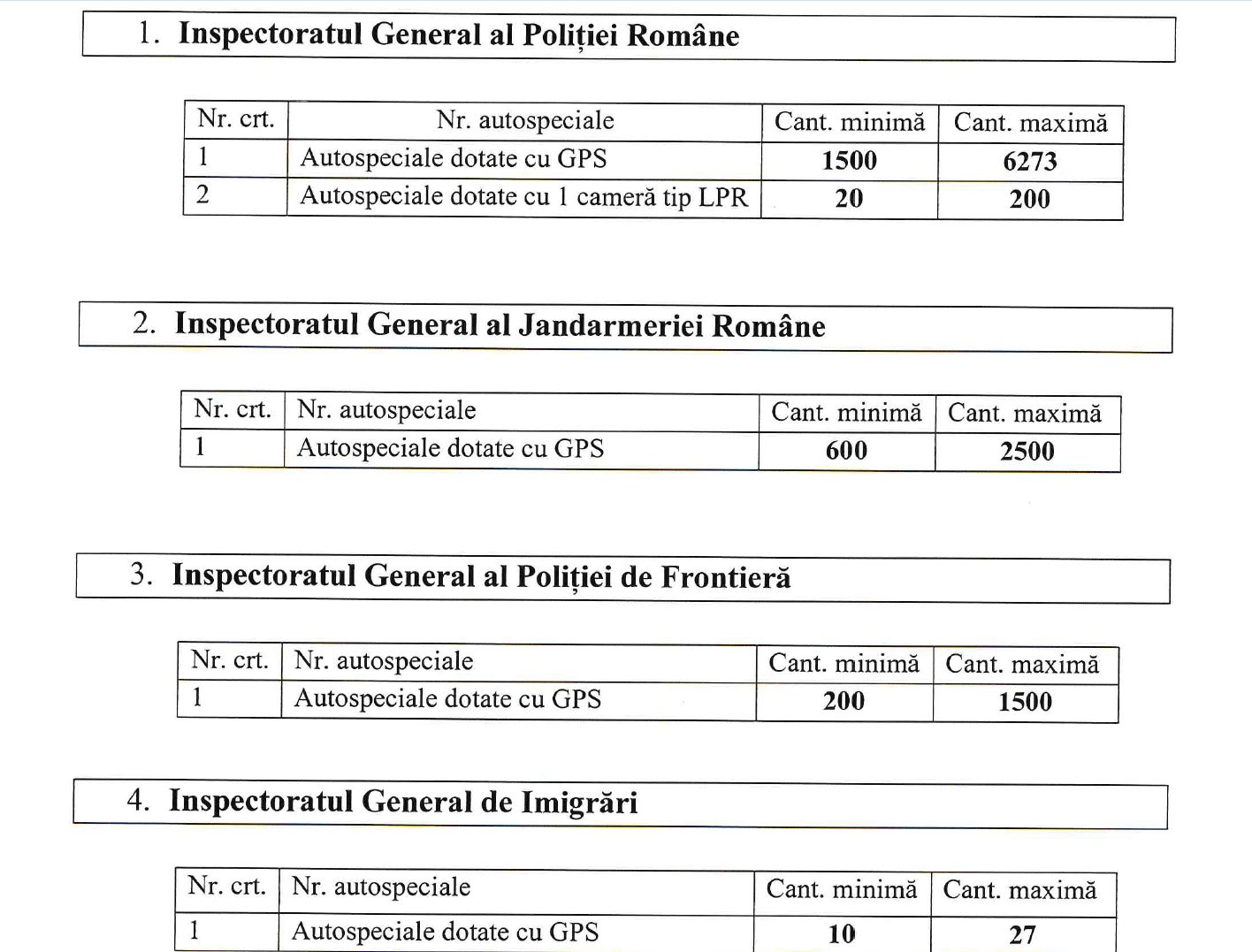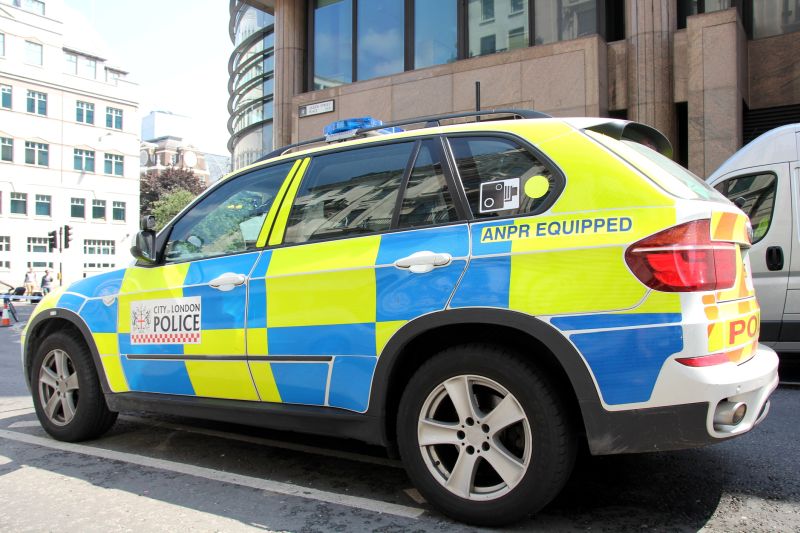
The police want to buy a GPS monitoring system for more than 10,300 cars, mainly Dacia Logan and Duster, and 200 cars will be equipped with LPR (License Plate Recognition) video cameras, a technology that allows to recognize car registration numbers in less time. than a second The contract is valued at more than 33.6 million lei.
The Romanian police launched a wave of tenders for the purchase of video surveillance systems using LPR (License Plate Recognition) technology, which allows automatic recognition of car registration numbers.
In addition to the 13.6 million lei auction for the purchase of a monitoring system with 300 LPR-type video cameras, which will be used, in particular, by police officers from the Office of Special Operations to fulfill mandates of technical surveillance of judges’ orders, the police launched a larger tender. aimed at interfering with traffic.
The General Inspectorate of the Police of Romania (IGPR) wants to acquire an integrated monitoring system for special vehicles on the streets, in order to be able to send and direct them to citizens’ complaints, especially those submitted through the 112 system managed by the STS, as quickly and efficiently as possible.
- SEE THE ASSIGNMENT HERE
The auction, which began on September 16, includes several lots and will benefit structures from the Romanian Police, the Romanian Gendarmerie, the Border Police and the General Immigration Inspectorate of the Ministry of the Interior.
10,300 police cars will be equipped with GPS monitoring

IGPR wants to conclude a 2-year framework agreement for the acquisition of an integrated monitoring system, which will consist of 2 subsystems, namely:
- subsystem of location, monitoring and fleet management via GPS.
- automatic license plate recognition subsystem – LPR (License Plate Recognition)
The specification clarifies that special vehicles of law enforcement agencies will be equipped with GPS-monitoring equipment, which will provide the possibility of their visualization on the map of the SNUAU application 112 of the Special Telecommunications Service (STS), which is currently used to process emergency calls.
- “It is desirable to install the GPS monitoring subsystem on approximately 10,300 registered special cars, the vast majority of special cars are Dacia Logan and Duster, 2018. Please note that special vehicles manufactured after 2019 are under warranty,” the police say.
Thanks to the implementation of the subsystem of location, monitoring and management of the car fleet through GPS for intervention at events, conditions will mainly be created for:
- reducing the time of intervention at events by determining the optimal routes to reach the place of intervention in the shortest time;
- possibility of priority direction of forces;
- the possibility of supplementing resources by providing the necessary support forces depending on their deployment on the spot;
A solution for monitoring forces acting on a street segment, will be interconnected with the STS platform/card (N/A system 112) so that the resource management process takes place with an emphasis on compliance with the principle “the nearest police officer intervenes”.
Also, this GPS monitoring system will offer logistics solutions to determine the functional parameters of the vehicle (route history, speed, fuel consumption, parking with/without engine stop, sudden turn, sudden braking, loss of GPS signal, GPS disconnection, as well as other operational parameters vehicle).
200 cars will have LPR video cameras for license plate recognition

The second subsystem for the automatic recovery of car registration numbers – LPR (License Plate Recognition) – is a video system that can be used for real-time identification of vehicles that are of operational interest, or that are engaged in criminal and illegal activities, or that are criminally liable , the police say.
The tender document states that a maximum of 200 IGPR vehicles will be equipped with one LPR camera each.
License plates will be removed at a distance of 7 to 20 meters
In the tender documentation The following technical requirements apply to LPR video cameras:
- License plates will be removed at a distance of 7 to 20 meters
- It will be equipped with high-efficiency IR LEDs with a wavelength of 850 nm, which will allow viewing images at night from a distance of at least 20 meters.
- This will allow at least 100,000 event records to be stored on the memory card and will include license plate images
- The number plate detection time will be less than one second
The LPR camera will come with an internal 256GB SD card.
In addition, LPR cameras will need to be installed ANPR software to run directly on the camcorder.
An ANPR program should have the following features:
- Automatic recognition of registration numbers with an accuracy of at least 95%
- Supports all EU license plates
- Allows you to create vehicle access lists: black list and white list
In addition to the license plate recognition function, the program will also offer the following features:
- Recognition of the car manufacturer and model
- Color recognition
- Classification of vehicles
- Determination of the direction of movement
Why is the police making this purchase: what are their problems now
In the specification, the police also explain what problems they currently have in intervening in traffic:
- “In certain situations, the location of incidents is carried out by intervention teams based on their knowledge of the area of responsibility or using landmarks provided by the subscriber, thus compensating for the lack of appropriate equipment for location determination and modern GIS maps.
- In the field, intervention crews may have difficulty identifying administrative addresses, even in situations where they have been reported and received correctly, due to the absence or placement of signs with the names of streets, administrative numbers, blocks and stairs in places with insufficient visibility. On-scene searches by emergency crews are reflected in delayed times and resources taken up more than would normally be required.
- All calls that are not accompanied by detailed location information require special efforts on the part of support structures to coordinate resources and parallel checks against databases/records or even to launch their own location mechanisms.
- In addition, it is not always known after an intervention that the intervened resource has become available again.
- In the event of an event that requires specialized intervention of police structures, dispatchers send forces to the scene, in general, according to a scripted situation, generally called “mirror of the post”, without having a special connection. a clear, up-to-date picture of the actual deployment of planned effective assets in service.
- No dispatcher of the national level has implemented a system of managing forces and means in the apparatus, therefore, in many cases dispatching at events is carried out strictly taking into account the experience of the service personnel and the level of their knowledge in the region. locality”.
The IGPR auctioned contract is divided into 7 lots and has an estimated value of over 33.6 million lei without VAT. The deadline for receiving tender offers or applications for participation is October 19, 2022. On the same day, a meeting on the opening of tender offers will also be held.
Photo sources: Burnstuff2003 | Dreamstime.com // Hieronymusukkel | Dreamstime.com
Source: Hot News RO
Anna White is a journalist at 247 News Reel, where she writes on world news and current events. She is known for her insightful analysis and compelling storytelling. Anna’s articles have been widely read and shared, earning her a reputation as a talented and respected journalist. She delivers in-depth and accurate understanding of the world’s most pressing issues.